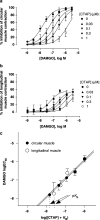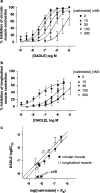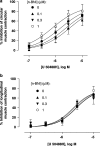Characterisation of opioid receptors involved in modulating circular and longitudinal muscle contraction in the rat ileum
- PMID: 15678085
- PMCID: PMC1576049
- DOI: 10.1038/sj.bjp.0706107
Characterisation of opioid receptors involved in modulating circular and longitudinal muscle contraction in the rat ileum
Abstract
1. The aim of the present investigation was to characterise the opioid receptor subtypes present in the rat ileum using a method that detects drug action on the enteric nerves innervating the circular and longitudinal muscles. 2. Neurogenic contractions were reversibly inhibited by morphine (circular muscle pEC50, 6.43+/-0.17, Emax 81.7+/-5.0%; longitudinal muscle pEC50, 6.65+/-0.27, Emax 59.7+/-7.8%), the mu-opioid receptor-selective agonist, DAMGO ([D-Ala2,N-Me-Phe4,Gly5-ol]enkephalin acetate) (circular pEC50, 7.85+/-0.04, Emax 97.8+/-3.6%; longitudinal pEC50, 7.35+/-0.09, Emax 56.0+/-6.1%), the delta-selective agonist DADLE ([D-Ala2,D-Leu5]enkephalin acetate) (circular pEC50, 7.41+/-0.17, Emax, 93.3+/-8.4%; longitudinal pEC50, 6.31+/-0.07, Emax 66.5+/-5.2%) and the kappa-selective agonist U 50488H (trans-(+/-)-3,4-dichloro-N-methyl-N-[2-(1-pyrrolidinyl)cyclohexyl]benzeneacetamide methanesulphonate) (circular pEC50, 5.91+/-0.41, Emax, 83.5+/-26.8%; longitudinal pEC50, 5.60+/-0.08, Emax 74.3+/-7.2%). Agonist potencies were generally within expected ranges for activity at the subtype for which they are selective, except for U 50488H, which was less potent than expected. 3. The mu and delta receptor-selective antagonists, CTAP (H-D-Phe-Cys-Tyr-D-Trp-Arg-Thr-Pen-Thr-NH2) and naltrindole, caused progressive, parallel rightward shifts in the DAMGO and DADLE curves, respectively. Analysis indicated conformity to theoretical simple competitive antagonist behaviour. U 50488H effects were insensitive to the kappa-selective antagonist, n-BNI. A high concentration (1 microM) of naltrexone caused apparent potentiation of U 50488H effects. 4. CTAP pK(B) estimates were consistent with previously reported values for mu receptor antagonism (circular 7.84+/-0.17, longitudinal 7.64+/-0.35). However, the naltrindole pK(B) estimates indicated lower antagonist potency than expected (circular 8.22+/-0.23, longitudinal 8.53+/-0.35). 5. It is concluded that mu and possibly atypical delta receptors (but not kappa receptors) mediate inhibition of contraction in this model. Nonopioid actions of U 50488H are probably responsible for the inhibitory effects seen with this compound.
Figures




Similar articles
-
Relationship between inhibitory effect of endogenous opioid via mu-receptors and muscarinic autoinhibition in acetylcholine release from myenteric plexus of guinea pig ileum.Jpn J Pharmacol. 1998 Aug;77(4):279-86. doi: 10.1254/jjp.77.279. Jpn J Pharmacol. 1998. PMID: 9749928
-
The role of nitric oxide in the development of opioid withdrawal induced by naloxone after acute treatment with mu- and kappa-opioid receptor agonists.Eur J Pharmacol. 1998 Oct 23;359(2-3):127-31. doi: 10.1016/s0014-2999(98)00684-0. Eur J Pharmacol. 1998. PMID: 9832382
-
delta-, but not mu- and kappa-, opioid receptor activation protects neocortical neurons from glutamate-induced excitotoxic injury.Brain Res. 2000 Dec 8;885(2):143-53. doi: 10.1016/s0006-8993(00)02906-1. Brain Res. 2000. PMID: 11102568
-
delta-Opioid receptor subtypes and cross-talk with mu-receptors.Trends Pharmacol Sci. 1993 Mar;14(3):84-6. doi: 10.1016/0165-6147(93)90068-u. Trends Pharmacol Sci. 1993. PMID: 8387705 Review. No abstract available.
-
U-50,488 and the kappa receptor: a personalized account covering the period 1973 to 1990.Prog Drug Res. 1999;52:167-95. doi: 10.1007/978-3-0348-8730-4_4. Prog Drug Res. 1999. PMID: 10396128 Review.
Cited by
-
Drug management of visceral pain: concepts from basic research.Pain Res Treat. 2012;2012:265605. doi: 10.1155/2012/265605. Epub 2012 Apr 24. Pain Res Treat. 2012. PMID: 22619712 Free PMC article.
-
Differences in the characteristics of tolerance to μ-opioid receptor agonists in the colon from wild type and β-arrestin2 knockout mice.Eur J Pharmacol. 2012 Jun 15;685(1-3):133-40. doi: 10.1016/j.ejphar.2012.04.001. Epub 2012 Apr 11. Eur J Pharmacol. 2012. PMID: 22521552 Free PMC article.
-
Mu opioid receptor expression is increased in inflammatory bowel diseases: implications for homeostatic intestinal inflammation.Gut. 2006 Jun;55(6):815-23. doi: 10.1136/gut.2005.080887. Epub 2005 Nov 18. Gut. 2006. PMID: 16299031 Free PMC article.
-
Endogenous opioid analgesia in peripheral tissues and the clinical implications for pain control.Ther Clin Risk Manag. 2005 Dec;1(4):279-97. Ther Clin Risk Manag. 2005. PMID: 18360571 Free PMC article.
-
Spasmolytic effect of stachys lavandulifolia vahl. Crude methanolic extract and fractions on rat ileum.Iran J Pharm Res. 2011 Spring;10(2):307-12. Iran J Pharm Res. 2011. PMID: 24250359 Free PMC article.
References
-
- ALZHEIMER C., TEN BRUGGENCATE G. Nonopioid actions of the kappa-opioid receptor agonists, U 50488H and U 69593 on electrophysiologic properties of hippocampal CA3 neurons in vitro. J. Pharmacol. Exp. Ther. 1990;255:900–905. - PubMed
-
- BAGNOL D., MANSOUR A., AKIL H., WATSON S.J. Cellular localization and distribution of the cloned mu and kappa opioid receptors in rat gastrointestinal tract. Neuroscience. 1997;81:579–591. - PubMed
-
- BIANCHI G., FERRETTI P., RECCHIA M., ROCCHETTI M., TAVANI A., MANARA L. Morphine tissue levels and reduction of gastrointestinal transit in rats. Correlation supports primary action site in the gut. Gastroenterology. 1983;85:852–858. - PubMed
-
- BIANCHI G., FIOCCHI R., TAVANI A., MANARA L. Quaternary narcotic antagonists' relative ability to prevent antinociception and gastrointestinal transit inhibition in morphine-treated rats as an index of peripheral selectivity. Life Sci. 1982;30:1875–1883. - PubMed
Publication types
MeSH terms
Substances
LinkOut - more resources
Full Text Sources
Other Literature Sources
Research Materials
Miscellaneous

